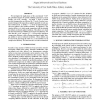Free Online Productivity Tools
i2Speak
i2Symbol
i2OCR
iTex2Img
iWeb2Print
iWeb2Shot
i2Type
iPdf2Split
iPdf2Merge
i2Bopomofo
i2Arabic
i2Style
i2Image
i2PDF
iLatex2Rtf
Sci2ools
ICIP
2004
IEEE
2004
IEEE
Spatial scalability and compression efficiency within a flexible motion compensated 3D-DWT
We investigate the implications of the conventional "t+2D" MC 3D-DWT structure for spatial scalability, and propose a more exible "2D+t+2D" structure. An initial levels of spatial wavelet decomposition are followed by levels of motion compensated temporal decomposition, applied separately to each spatial resolution level. A further ? levels of spatial decomposition are applied to the resulting subbands. By adjusting , the structure allows us to trade energy compaction with the potential for artifacts at reduced spatial resolutions. This allows us to study the interaction between scalability and compression efciency. We show that the "t+2D" structure ( = 0) necessarily maximizes compression efciency, while allowing misaligned spatial aliasing artifacts to arise at reduced resolutions. These artifacts can be removed by increasing the value of , at an inevitable cost in compression efciency. We show how this cost can be minimized.
ICIP 2004 | Image Processing | Spatial Aliasing Artifacts | Spatial Decomposition | Spatial Resolution Level | Spatial Scalability | Spatial Wavelet Decomposition |
| Added | 24 Oct 2009 |
| Updated | 24 Oct 2009 |
| Type | Conference |
| Year | 2004 |
| Where | ICIP |
| Authors | Nagita Mehrseresht, David Taubman |
Comments (0)

